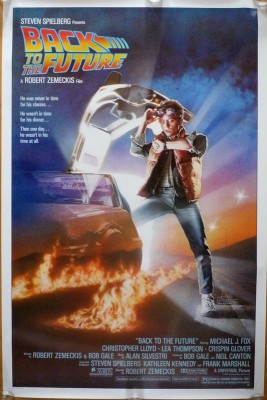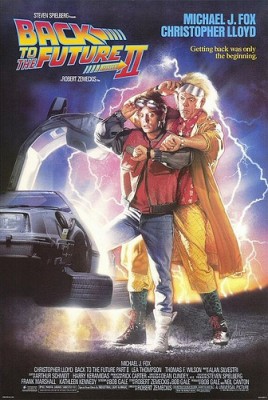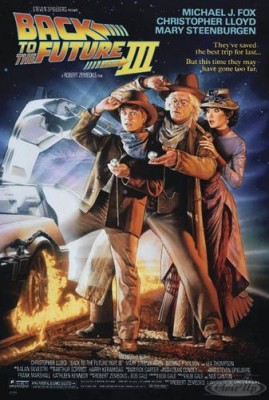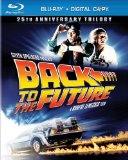| Reviews & Columns |
|
Reviews DVD TV on DVD Blu-ray 4K UHD International DVDs In Theaters Reviews by Studio Video Games Features Collector Series DVDs Easter Egg Database Interviews DVD Talk Radio Feature Articles Columns Anime Talk DVD Savant Horror DVDs The M.O.D. Squad Art House HD Talk Silent DVD
|
DVD Talk Forum |
|
|
| Resources |
|
DVD Price Search Customer Service #'s RCE Info Links |
|
Columns
|
|
|
Back to the Future - 25th Anniversary Trilogy
More than most of my colleagues here at DVD Talk, in the quarter-century since Back to the Future's release, I've grown to absolutely loathe 95% of high-concept, big studio movies stacked to the gills with extravagantly overdone CGI special effects, visceral, thrill ride-type action set pieces, infantile screenplays, and humanity and characterization in short supply - movies that, to some degree, are the progeny of earlier blockbusters like Back to the Future.
And yet the first Back to the Future is still the same pleasant surprise* it was when it was new: a high-concept movie that's really works, almost to perfection. Despite some awkward, '80s-era materialism that seemed odd even then and a few overplayed gags, Back to the Future is just about everything you'd want a film to be. It's extremely clever, densely packed with imagination and innovation, and highly amusing with myriad funny moments. It's disarmingly sweet and even touching thanks to its appealing characters and strong performances, and it's genuinely suspenseful and unpredictable, with a real sense of wonder.
The two sequels, Back to the Future's Part II (1989) and Part III (1990), are similarly clever but considerably less satisfying. Part II especially lacks the original film's heart and both repeatedly resort to a painfully clumsy device to propel certain story elements. Part II is more effects-driven and unappealingly dark, though in some ways its story is a logical progression from the first picture. The last film of the trilogy introduces a sweet romance though the casting makes plain that another, better movie heavily influenced its creation. Even so, each is ingenious in its own way and they're well worth watching on their own terms. I looked at the trilogy on Blu-ray over three consecutive nights, and it plays better that way than it did in its more spaced-apart theatrical run.
Universal's Back to the Future - 25th Anniversary Trilogy repackages older supplements with a wonderful, new multi-part documentary directed by Laurent Bouzereau, one of the best producer-directors of these sort of retrospectives. The transfers of all three films are outstanding, notably superior to their original 35mm runs.
In Back to the Future (1985), Marty McFly (Fox) is a typical California teenager from an ordinary, slightly downtrodden middle-class family. His unassertive, nerdy father, George (Crispin Glover), is constantly being taken advantage of by his supervisor at work, Biff Tannen (Thomas F. Wilson), while his mother, Lorraine, is a puffy-faced alcoholic. Marty, an aspiring rock guitarist, spends most of his spare time with girlfriend Jennifer (Claudia Wells) and at the laboratory of eccentric inventor Dr. Emmett "Doc" Brown (Christopher Lloyd).
Doc reveals that he's perfected a time machine, built on the chassis of a DeLorean DMC-12, but in order to generate the 1.21 gigawatts of power needed Doc essentially swindled a group of Libyan terrorists out of their stolen plutonium. They show up just as the mobile time machine is being tested - Doc is gunned down by machine-gun fire and Marty, terrified, escapes in the DeLorean, unaware it's programmed to travel to November 5, 1955.
In his same hometown of Hill Valley of 30 years before, Marty has a chance encounter with his own father (also Glover), now a high school senior himself. Marty inadvertently prevents George's fateful first meeting with Marty's mother, Lorraine (also Thompson), thus upsetting the established time continuum. Indeed, instead of falling head-over-heels in love with George, she becomes strongly sexually attracted to Marty, unaware (of course) he's her future son.
Marty locates a younger Doc Brown who, amazed by his own future ingenuity, quickly agrees to help Marty back to the future. But there are several problems: first, without plutonium the only source of the kind of energy capable of propelling the DeLorean forward in time is a bolt of lighting; second, having upset the time continuum, Marty (along with his two siblings) are in danger of fading into non-existence unless he can bring his parents together into a lasting relationship while avoiding the dim-witted teenage bully version of Biff (also Wilson), who threatens to ruin everything.
Back to the Future is one shrewd movie. Writers Robert Zemeckis (who also directed) and Bob Gale carefully establish Marty's 1985 world and its characters before reintroducing everything in its 1955 setting to allow constant references and ironies between the two time periods. More importantly, their writing and the charming performances by the four leads prompts a strong response: the audience is really rooting for George and Lorraine to find one another, and for Marty to find a way to warn the 1955 Doc about 1985 Doc's murder, despite the inventor's emphatic refusal to learn his ultimate fate.
Lea Thompson and Crispin Glover were almost complete unknowns in 1985, and for starters this made their visual contrast between middle-aged parents and youthful, Eisenhower-era teenagers all the more striking and surprising. Today their make-up prosthetics as the older George and Lorraine are pretty obvious but when the film was new most in the audience were completely fooled, and like Marty quite shocked when they're reintroduced in 1955.
Both actors are marvelous, recalling the similar dynamic between Betty Hutton and Eddie Bracken in Preston Sturges's wonderful The Miracle of Morgan's Creek (1944). Oedipal concerns aside, she's both sweetly innocent and hotly amorous toward Marty, a funny, tense conflict ultimately resolved in a simple, charming, and believable scene near the end. Like Hutton Thompson is spirited and sexy; it's a real star-making performance.
The notoriously eccentric Glover is, like Bracken, one of a kind and perfectly cast. His pained, almost perennial desperate facial expressions and awkward gesturing is extremely funny yet always genuine - a fully realized characterization rather than broad clowning a la the young Jerry Lewis. Similarly, Lloyd gives the kind of committed performance he seems to specialize at; Doc's passion, respect and wild-eyed amazement toward science really sells the story's science fiction angle, while the character's affection toward Marty is equally authentic.
Fox replaced actor Eric Stoltz about five weeks into shooting. Stoltz was and is arguably the better dramatic actor, but Zemickis and others felt he wasn't getting the comedy across, and their instincts were probably right. Fox's performance mostly consists of reacting to others, for which he provides endless and often very funny variations and, like the other leads, he's enormously likable.
Next came Back to the Future Part II (1989), whose dizzyingly Byzantine script begins precisely where Back to the Future left off: Marty and girlfriend Jennifer (now played by Elisabeth Shue)** join Doc on a trip 30 years into the future, where Marty and/or Jennifer get a glimpse of their future selves, as well as their own teenage children, Marty Jr. and Marlene (both played by Fox). But a by-now old and crotchety Biff briefly steals the DeLorean, giving a sports almanac - with statistics through the year 2000 - to his younger self in the year 1955. That Biff uses the information to become obscenely rich and powerful, resulting in a darkly transformed 1985. When Marty, Jennifer, and Doc return to the present, they learn that Marty's father had been murdered by Biff years before, that his mother has become Biff's alcoholic, abused wife, and that Doc has been committed to a mental institution. To unravel this mess, Marty and Doc travel to 1955 to snatch the sports almanac away from young Biff, while gingerly trying to avoid the other Marty and Doc playing out the events covered in the first picture.
Produced at a cost of more than twice the original film, Back to the Future Part II is extremely clever, ingenious even, especially in the way it folds the events of the first picture into the second, with much humorous crossover. The technophilic future (flying cars, holographic movies) isn't realistic but amusingly satirical - unbridled capitalism run amok. (Ironically, this Universal Studios-produced vision of the future closely resembles the company's later, grotesque CityWalk, which opened a few years later.)
The 2015 scenes are crammed with special effects - far more than are needed, really - while both the 2015 scenes and the third act in 1955 use a then-remarkable process called VistaGlide, which almost seamlessly allows one actor playing multiple roles within a single shot to interact with his various "co-stars." Both the process and the performances of the actors involved are very impressive.
Unfortunately, Part II has almost none of the original film's heart, partly because it's more frenetic and action-/special effects-driven, partly because the film's focus is on its garish future and dystopic present, in scenes dominated by actor Wilson, who is excellent as both Biff and Griff (Biff's equally dumb grandson), the former seen at ages 17, 47, and 77.
Possibly another factor is the absence of Crispin Glover, who could not come to terms with the producers and opted out of the two sequels. In heavy makeup and shot in various ways to obscure his features, actor Jeffrey Weissman replaced Glover for some scenes while footage from the first picture featuring Glover was used elsewhere. Regardless, the character remains in the background and Glover's absence is keenly felt, perhaps in turn minimizing Thompson's role in the two sequels as well, and certainly throwing those films off-balance.
Another problem is the extremely clumsy device Zemeckis and Gale repeatedly use to jerk both Part II and III's stories forward. Early on they introduce the idea that, in contrast to the easygoing teenager of the first film, Marty in the sequels is easily upset whenever his manhood is questioned. Call him a "chicken" and, blood boiling, he's apt to become violent like a commuter with road rage and armed with a tire iron. Overcoming this predilection becomes something like a theme in Part III, but it's simply unappealing and sloppy in terms of storytelling.
Filmed consecutively, most of it immediately after production on Part II, Back to the Future Part III (1990) takes the series into a refreshingly different direction, with most of the film spent in Hill Valley circa 1885, where Doc, unable to repair the damaged DeLorean is threatened by Biff's ancestor, Buford "Mad Dog" Tannen (also Wilson). Marty adopts the name "Clint Eastwood" but fails to impress the mangy outlaws and old-timers at the local saloon (played by genre veterans Dub Taylor, Harry Carey Jr., and Pat Buttram).
With no gasoline to power the DeLorean, Doc hits upon a plan to build up the necessary 88 miles per hour needed to travel back to the future by having the vehicle pushed by a speeding locomotive engine. Meanwhile Doc becomes romantically attached to the newly arrived schoolteacher, Clara Clayton (Mary Steenburgen), who like Doc has a passion for science ... and Jules Verne.
This sweet romance is Back to the Future Part III's best feature, even if it's clearly derived from another movie, Time After Time (1979). In both films, a time traveler falls in love with a spunky, assertive woman attracted to his eccentric ways; when he reveals to her that he's from another time she becomes terribly upset, refusing to believe his story, but in the end joins him on his time travels. And in both films the same actress, Mary Steenburgen, plays the role of the woman. Fans of the older film were simultaneously appalled and delighted, a strange and conflicting reaction.
The story was prompted by the filmmakers' fondness for the Westerns they had enjoyed in their youth but one wonders how the series' primary target audience - 18-24 year-olds who probably had never seen a Western in their lives*** - responded. For Western fans though, the film is warmly nostalgic: the Monument Valley locations, the Russell Harlan/William Clothier-esque cinematography, the use of veteran character players.
The story is generally better, though as with Part II the climax doesn't work as well as the first film because the special effects and stunt work tend to overwhelm the characters. Where the first picture wisely kept the special effects to a minimum, the last two pictures are almost obsessed with the latest filmmaking technology. And where the first film made its fantastic premise entirely logical and believable, this one concludes with a bit of admittedly charming but wildly improbable fantasy. Still, the final scene between Marty and Doc is actually quite touching, wrapping up the trilogy in a satisfying manner.
Video & Audio
Back to the Future - 25th Anniversary Trilogy comes in packaging that folds out into a kind of triptych, with digital copy discs of each film logically positioned behind each Blu-ray. The layout of the set and all the menu designs on the discs are extremely user-friendly, though the packaging itself is another matter. As with their recent boxed set of The Office, the discs are locked into plastic hubs and extremely difficult to remove without breaking or scratching the discs.
Despite complaints elsewhere about the image quality I found all three films, presented in their original 1.85:1 theatrical aspect ratios, quite excellent throughout. Back in the mid-1980s through early-1990s, when print runs ballooned into the thousands, the quality of 35mm theatrical prints was often quite poor, and I recall the first and second films especially looking fairly ugly in theaters, soft and grainy at once. Here, straight cuts without optical effects look superb, with a razor sharp clarity, rich color, solid blacks and good contrast. The complex optical effects, some of which are composed of a dozen or more separate elements, are necessarily softer, but casual, non-techno-geek viewers aren't likely to notice. The sharper image does reveal more of the trickery, however, especially in terms of the hair and make-up though, oddly, Elisabeth Shue's wig much more so that the old-age prosthetics applied to Thompson, Wilson, and Glover.
The audio is equally impressive, with lossless 5.1 DTS-HD Master Audio (along with 5.1 French and Spanish DTS Surround tracks) getting a full work-out on all three superbly-mixed films, superbly-mixed films. Optional subtitles in all three languages are available.
Extra Features
While virtually all of the original standard-def DVD special features have been ported over for this release, there's also a lot of new material as well, nearly all of it in high-definition. What's really nice about the new stuff is that it's entirely satiating all by itself. After watching the new documentaries and other supplements I felt little need to go back and look at the older DVD-era material.
The centerpiece of all this is Laurent Bouzereau's six-part documentary covering the writing and production of the entire trilogy, spread over the three discs and running a total of 126 minutes, longer than the longest of the three features. It's fascinating stuff, and like Bouzereau's other documentaries for Universal refreshingly frank about thorny issues like the firing of Eric Stoltz and Crispin Glover's absence from the last two films. Most of the main cast and crew are interviewed, including Zemeckis and Gale, executive producer Steven Spielberg, Fox, Lloyd, and Thompson, and there's a ton of previously unseen material, including some brief footage of Stoltz as Marty McFly.
Two short but valuable featurettes that didn't quite fit in the main documentaries are also worth a look: The Physics of 'Back to the Future' and Nuclear Test Site Ending Storyboard Sequence, the latter about the first film's scripted but scrapped original climax. These and the main documentary are all in 1080p high-definition.
Also new is a half-hour featurette hosted by Leslie Nielsen that accompanied the first film's network television premiere.
Previously released material includes deleted scenes and original trailers, all bumped up to high-definition. The rest, in standard-def, include previously released archival featurettes; older behind-the-scenes documentaries, including a Back to the Future: The Ride featurette, with all of the video and film footage from the ride itself (featuring Lloyd and Wilson); a Michael J. Fox Q & A; music videos and photo galleries. There are two commentary tracks covering much of the same material included in the better Bouzereau-produced documentaries, the first featuring Zemeckis and Gale, the second with Gale and co-producer Neil Canton.
Parting Thoughts
I hadn't seen the trilogy for many years, but had a blast watching the first Back to the Future again and enjoyed, with some reservations, the two sequels well enough. The new documentaries are excellent and engaging, while the high-def transfers are vast improvements over their original 35mm theatrical release versions. A DVD Talk Collector Series Title.
* Michael J. Fox was at the time was starring on the popular sitcom Family Ties. This may have lured some in the audience, but for me it was a good reason not to see the film. But his excellent performance surprised me, and the audience I saw the film with responded with much spontaneous applause throughout.
** Busy caring for her ailing mother, Claudia Wells was unable to reprise her role from the first picture.
*** A bit of an exaggeration (yes, they may have flocked to Young Guns, for instance),but largely true, certainly. How many 18-24-year olds in 1990 would have even heard of Shane or High Noon or Stagecoach?
Stuart Galbraith IV's latest audio commentary, for AnimEigo's Musashi Miyamoto DVD boxed set, is on sale now.
|
| Popular Reviews |
| Sponsored Links |
|
|
| Sponsored Links |
|
|
| Release List | Reviews | Shop | Newsletter | Forum | DVD Giveaways | Blu-Ray | Advertise |
|
Copyright 2024 DVDTalk.com All Rights Reserved. Legal Info, Privacy Policy, Terms of Use,
Manage Preferences,
Your Privacy Choices | |||||||
















